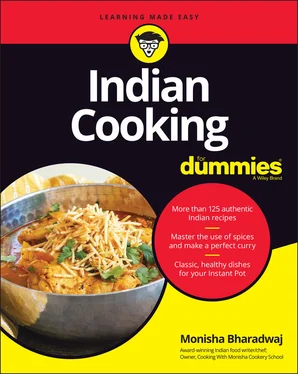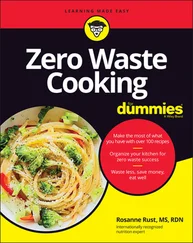Bring your tin to the stovetop, and hold it in one hand as you add spices with the other. This will reduce spillage (think of those little mustard seeds that might escape), and you’ll have the next spice on hand, if they’re going into the pan in a sequence. If you think you need to practice spooning out your spices neatly, mix them in a small bowl before you begin cooking. Remember to only mix those that go into the pan at the same time, so seeds and powders will have to be kept separate (see Chapter 8).
Clean your tin regularly. You’ll notice that the tin gets a bit grungy after a few uses. Lift out the little bowls and give the tin a good wipe with clean paper towel. Once in a while, you can tip the spices into other bowls and give the whole tin a good wash. Dry it completely before reintroducing the spices.
Tools for blending and crushing spices
A blender is the secret to many curries. You’ll want a blender for pureeing curry base sauces and smaller appliances or utensils for crushing small amounts of spices. Here’s what to look for:
Blender: A blender is a must-have in the Indian kitchen. In the days before blenders, people used grinding stones that produced concentrated curry pastes, but they required a lot of elbow grease. Choose a blender that can puree rather than a food processor that chops very finely. You’ll want a powerful one with a high wattage, so it gets everything smooth. Some blenders have attachments for wet and dry blending or compact jars for smaller quantities. Washing your blender thoroughly is important. Check to see if the base comes apart from the jar and undo it each time you clean it.
Spice mill or grinder: You may think that spices need to be crushed every time you begin cooking a curry, but that isn’t true. It’s perfectly acceptable to use ready-bought spices, although some, such as ground coriander or garam masala, lose their flavor very quickly so either use them up soon or grind them at home. Investing in a small electric spice or coffee grinder will make crushing those seeds, bark, and nuts feel like child’s play, and your kitchen will smell heavenly, too! I suggest not blitzing coffee and spices in the same mill (excuse me waiter, there’s a coriander seed in my coffee). And remember to wipe out the mill after each use.
Mortar and pestle: A good mortar and pestle is essential in your Indian kitchen because you’ll use it a lot. Look for a heavy one (for example, one made of granite) that’s hard enough to crush tough spice seeds. I find that a ceramic mortar and pestle is too delicate for robust spice crushing. Wash your mortar and pestle after each use to keep the flavors of different blends distinct.
Peppermill: You’ve probably already got a peppermill at home that you use for crushing peppercorns. Buy another one and fill it with toasted spice seeds (try cumin). A few turns over curry will give an instant top note of fresh spice flavor.
Chapter 4
Shopping for Essential Ingredients
IN THIS CHAPTER
 Stocking up on dry goods
Stocking up on dry goods
 Loading your pantry with canned goods
Loading your pantry with canned goods
 Making the most of dairy and eggs
Making the most of dairy and eggs
 Choosing ghee and oils
Choosing ghee and oils
 Handpicking the freshest produce
Handpicking the freshest produce
 Knowing what to look for in meat and poultry
Knowing what to look for in meat and poultry
If this is the first time you’re trying your hand at Indian cooking, you may be wondering where to begin with ingredients. The good news is that you don’t need a lot of specialty ingredients to prepare your Indian feast. But having some well-chosen ones will definitely up your game.
When you feel like cooking an Indian dinner, your well-stocked pantry can give you lots of inspiration and save time and money, too. No last-minute dash to the corner shop to buy expensive spices or lentils. A well-planned pantry and fridge can work hard for you, leaving you to enjoy the preparation and the eating of your meal.
Every good pantry has a stock of dry goods that can be bought in bulk because they have a long shelf life. This saves money and means you don’t have to add those items to your weekly shopping list.
 Make sure your pantry is dry and packets are stored in airtight containers to keep pests away. You want to feed yourself, not the mice!
Make sure your pantry is dry and packets are stored in airtight containers to keep pests away. You want to feed yourself, not the mice!
You need to need to get them right in order for your Indian cooking to work well. I’m always excited to see rows and rows of colorful spices at my local Indian shop. The aromas that hint of faraway lands are no less tantalizing. However, I’m aware of how overwhelming all this can seem to a novice. Spice names written in various Indian languages and scripts, as well as whole, crushed, and powdered forms of the same spice can be too much to handle. Plus, there are all those variations — for example, chile powder sold in various strengths of pungency, as well as from different regions of India.
Don’t worry, I won’t be going to ask you to go buy out your local Indian market. A few key spices and spice blends are all you need. After you’ve tested a few different brands and found the ones you love, you’ll be shopping like a pro!
 When buying and storing spices and herbs, here are some useful tips.
When buying and storing spices and herbs, here are some useful tips.
Buy from a shop that does a brisk business. When lots of other shoppers go there to buy spices, shelves will be restocked more frequently and spices will be fresher. Typically, this means shopping at an Indian grocery store.
Buy small quantities. Often, buying in bulk is cost-effective, but in the case of spices, it isn’t. Ground spices last for around six months; the seeds last for a year. Even if a big bag is cheaper than several smaller ones, you may end up needing to throw it out. Better to buy two or three smaller bags and open one only after you’ve used up the previous one.
Store them in airtight containers in a dry, dark cupboard. Spices and herbs can deteriorate with light and air.
Use spices in other cuisines, too. That way, you’ll use them up faster and keep your stock fresh. Try adding a pinch of turmeric to rice and pasta, or add a bit of garam masala to your roast meat.
Depending on what your go-to recipes will be, buy a few key spices first and then build up your collection. The spices I can’t live without are:Black mustard seedsChile powderCumin seedsGaram masalaGround corianderGround cuminTurmeric
Table 4-1can help you decide which spices to buy and suggests which dishes they compliment. When you become familiar with their flavors, you’ll feel confident to use them in other recipes too.
TABLE 4-1Buying Spices
| Spice |
Description |
| Ajowan |
Also called ajwain, these small, sharp-tasting seeds give Indian fritters like onion bhajia and snacks their distinctive taste. |
| Amchur |
Sometimes spelled amchoor, this is a dried green mango powder used to add a fruity sour note to samosa and stuffed bread fillings where moisture needs to be restricted. It’s also used in North Indian chutneys and salads. |
| Asafetida |
This very strong-smelling powder comes from the root of a plant species of ferula. It’s used in small quantities for its digestive properties in recipes with lentils, beans, and certain vegetables. If you just can’t find it and a recipe calls for it, you can just leave it out. |
| Cardamom |
Green cardamom is used in both savory and sweet recipes. It has a strong citrusy aroma. Black cardamom is bigger and has a smoky aroma. Look for plump pods when buying both. |
| Chaat masala |
Chaat masala is a spicy, sour, salty blend of spices such as mango powder and chile. It’s sprinkled over snacks as a finishing spice. It’s sometimes sold as “chunky chaat masala.” |
| Chile powder |
Varying heat levels are available, from mild to extra hot. I suggest a medium-hot variety, such as Kashmiri chile powder, which also gives dishes a lovely deep red color. |
| Cinnamon |
The quills are crumbly, sweet, and aromatic. You can substitute cinnamon with cassia, which is cheaper, coarser, and slightly bitter but still aromatic. Both cinnamon and cassia are used in rice dishes and some curries. |
| Coriander |
Coriander is available as seeds and ground — you’ll need both. Buy smaller packs of ground coriander because it loses its aroma quite quickly when opened. ( Note: The leaves and stem of this plant are referred to as cilantro, but coriander is the term used for the dried seeds.) |
| Cumin |
These small, long seeds are highly aromatic. You’ll need both the seeds and ground cumin. |
| Garam masala |
Garam masala is an aromatic blend of spices such as cardamom, cinnamon, cloves, coriander, cumin, nutmeg, and pepper. Recipes vary so find a blend you like. |
| Fenugreek |
Fenugreek is available as seeds and dried leaves, which are essential in dishes like butter chicken. The seeds are used in lentil and vegetable dishes. You can’t swap leaves with seeds, or vice versa, so pay attention to what the recipe calls for. |
| Mustard seeds |
Mustard seeds are used a lot in South Indian cooking. Look for black or brown ones. Yellow mustard seeds are not commonly used. |
| Pepper |
Pepper is used in spice blends and for seasoning. Buy black peppercorns and crush them at home in a peppermill for the freshest flavor. |
| Saffron |
Saffron is the world’s most expensive spice. Look for Spanish or Kashmiri saffron. It’s used in small quantities in sweets and rice dishes. |
| Turmeric |
This bright yellow-orange powder has an earthy aroma. Look for a vibrant hue. Fresh turmeric root is also available, but you can’t use it instead of the powder in Indian recipes. (I tried, so you don’t have to.) |
| Whole dried chilies |
You’ll need chilies to add color and flavor to some curries such as rich lamb curries or South Indian dishes. Choose a dark red, mild variety such as Kashmiri chilies. |
Читать дальше

 Stocking up on dry goods
Stocking up on dry goods Make sure your pantry is dry and packets are stored in airtight containers to keep pests away. You want to feed yourself, not the mice!
Make sure your pantry is dry and packets are stored in airtight containers to keep pests away. You want to feed yourself, not the mice!










